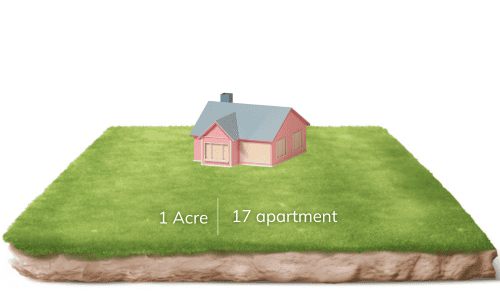As far as real estate is concerned, lot size refers to the dimensions of the land on which your property sits. Generally, lot size is determined by calculating the area of your land, meaning careful measurements of its width and length are necessary.
From my definition, I’m sure you’ve figured out the differences between lot size vs house size and how the latter is influenced by the former. And if you’re wondering, “what size house will fit on my lot?” rest assured that you’re not the only one to do so.
Theoretically speaking, in some areas, you can build a house as big as the lot itself, although most states will have setback requirements and easements that impede this. A more reasonable approach would be opting for a floor-to-area ratio (FAR) of 1.25 to 3.5.
Table of Contents
What Size House Can You Build on Your Designated Slot?
To learn the maximum house size you can build, check the easements and setback requirements in your local area. Subtract those figures from your lot dimensions, and you’ll end up with the building envelope—the area on which you can build your house.
Of course, going for the biggest (or smallest) house size as legally possible is not always the best approach. Rather, the ideal house size should reflect that you’ve used your property to its full potential without cramping the lot.
See the sections below for more details.
1. Maximum/standard House Size for Specific Lot Types
As established above, lot measurements will directly impact your house plans. The thing is, lot size doesn’t remain consistent across states, ranging from 7,405 to 78,408 square feet.
The takeaway here is: the standard lot size will change depending on what area you’re talking about, and by extension, so will the standard house measurements. Urban areas tend to have smaller lots, whereas you’ll see bigger allotments the closer you get to the countryside.
Let’s check out the standard lot size house in different regions of the US:
| Region | Lot size (Square feet) |
Lot size (Acre) |
Lot size classification | House size (Square feet) |
| Urban areas | 4,356 to 6,534 | 0,1 to 0,15 | Small | 1,500 |
| Suburban areas | 8,712 to 10,890 | 0,2 to 0,25 | Small to mid-sized | 2,000 to 2,500 |
| 10,890 to 13,068 | 0,25 to 0,3 | Large | 2,500 to 3,000 | |
| Rural areas | 21,780 and above | 0,5 and above | Large | 4,000 to 20,000 and above |
- For example, Iowa, South Dakota, and Utah have 10,000 sq ft lots and larger, so residents here can build a 2,500 sq ft house.
- Nevada and California have relatively modest acreage—less than 8,330 square feet, so the total area of your home should be around 1,500 sq ft.
2. House Capacity on Different Land Sizes
Aside from considering how big of a house can you build on your allotment, you also have to think about whether the house can accommodate the intended number of residents.
This brings us to the next question—how much land do you need for a residence large enough for your family? Below are our estimates:
1. Below 0,25 acre
Although less than 0.25 acre may not sound like a lot, you can build a house with 2 to 3 bedrooms. However, make sure that the allotment has public water and sewage systems first, as they may affect your home’s placement and size.
Since the minimum lot size to build a house is 320 square feet, the smallest accommodation you can opt for is one with 1 bedroom, 1 bathroom, and no garage.
2. 0,25 acre
Generally, 0.25 acre is a good lot size for a home for a single family requiring 3 to 4 bedrooms with enough spare space for entertainment areas or home offices. It’s also possible to construct a three-car garage here without cramping the land.
A quarter acre lot also allows for multi-dwelling housing, so it’s not out of the realm of possibility to erect 3 to 4 small homes here or a small apartment complex for 11 households.
3. 0,3 acre
You can design the footprint of a house for a lot this size to accommodate up to 5 bedrooms, which is enough for two single-family homes or one with a live-in staff. Alternatively, you can construct 5 homes or an apartment complex for 14 households.
4. 0,5 acre
At the very least, you can expect a 0.5-acre lot to accommodate three single-family households. That said, it’s large enough for eight 2,500-square-foot houses, which are bigger than the average single-family home in the US already.
5. 1 acre
Frankly speaking, an acre is really big—almost 2/3 the size of a football field. To fully utilize the land, feel free to erect up to 17 homes or turn the acreage into a farming site.
Determining the right house size
- First and foremost, calculate the size of your lot if you don’t know it already. To simplify the process, use an online house lot size calculat
- Look up the easements and requirements for front, side, and rear setbacks in your local area.
Your home cannot overlap the easements or setbacks, so avoid these segments; otherwise, you’ll have to tear down the property later on. On the remaining land, you can build your homes, garages, pools, etc.
- Conduct a topography survey to pick the best spot for house construction and identify potential problems so that you can address them accordingly in time.
- With everything taken into account, you should have an idea of how large you can build your house. I’d suggest going for a 25 to 3.5 floor-to-area ratio, but check the local zoning code first and see if it specifies this requirement.
- To avoid wasted or insufficient space, consider the following factors:
-
- Number of desired bedrooms: note that the average bedroom size is 224 square feet, although you can reduce it to as small as 168 sq ft.
- Storage needs
- Whether you or your family members plan to have babies
- Whether any of the room can serve multiple purposes
- The possibility of overnight guests
- Other requirements: home office, garage, pool, entertainment area, etc.
Conclusion
Determining what size house will fit on my lot is an essential step in home construction. You’ll have to take into account several factors, such as easements, setbacks, topography, personal needs, and your own budget.
If you’re still struggling to find an ideal home size for your lot, it’s best to consult a professional architect, as they’ll be able to cater to your specific case.

Hi, I am Roseanne Jones, an aspiring home designer that wants to make you feel more at home with your new house.With nearly five years of redecorating old residents and arranging new ones, I am confident that I can give you the best advice on your lovely place.
























